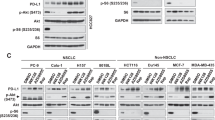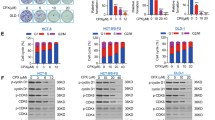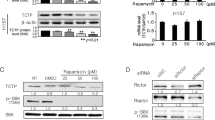Abstract
The mammalian target of rapamycin (mTOR) is commonly activated in colon cancer. mTOR complex 1 (mTORC1) is a major downstream target of the PI3K/ATK pathway and activates protein synthesis by phosphorylating key regulators of messenger RNA translation and ribosome synthesis. Rapamycin analogs Everolimus and Temsirolimus are non-ATP-competitive mTORC1 inhibitors, and suppress proliferation and tumor angiogenesis and invasion. We now show that apoptosis plays a key role in their anti-tumor activities in colon cancer cells and xenografts through the DR5, FADD and caspase-8 axis, and is strongly enhanced by tumor necrosis factor-related apoptosis-inducing ligand (TRAIL) and 5-fluorouracil. The induction of DR5 by rapalogs is mediated by the ER stress regulator and transcription factor CHOP, but not the tumor suppressor p53, on rapid and sustained inhibition of 4E-BP1 phosphorylation, and attenuated by eIF4E expression. ATP-competitive mTOR/PI3K inhibitors also promote DR5 induction and FADD-dependent apoptosis in colon cancer cells. These results establish activation of ER stress and the death receptor pathway as a novel anticancer mechanism of mTOR inhibitors.
This is a preview of subscription content, access via your institution
Access options
Subscribe to this journal
Receive 50 print issues and online access
$259.00 per year
only $5.18 per issue
Buy this article
- Purchase on Springer Link
- Instant access to full article PDF
Prices may be subject to local taxes which are calculated during checkout







Similar content being viewed by others
References
Siegel R, Naishadham D, Jemal A . Cancer statistics, 2012. CA Cancer J Clin 2012; 62: 10–29.
Vogelstein B, Papadopoulos N, Velculescu VE, Zhou S, Diaz LA Jr, Kinzler KW . Cancer genome landscapes. Science 2013; 339: 1546–1558.
Laplante M, Sabatini DM . mTOR signaling in growth control and disease. Cell 2012; 149: 274–293.
Sonenberg N, Hinnebusch AG . Regulation of translation initiation in eukaryotes: mechanisms and biological targets. Cell 2009; 136: 731–745.
Zhang YJ, Dai Q, Sun DF, Xiong H, Tian XQ, Gao FH et al. mTOR signaling pathway is a target for the treatment of colorectal cancer. Ann Surg Oncol 2009; 16: 2617–2628.
Gulhati P, Cai Q, Li J, Liu J, Rychahou PG, Qiu S et al. Targeted inhibition of mammalian target of rapamycin signaling inhibits tumorigenesis of colorectal cancer. Clin Cancer Res 2009; 15: 7207–7216.
Gulhati P, Bowen KA, Liu J, Stevens PD, Rychahou PG, Chen M et al. mTORC1 and mTORC2 regulate EMT, motility, and metastasis of colorectal cancer via RhoA and Rac1 signaling pathways. Cancer Res 2011; 71: 3246–3256.
Thoreen CC, Chantranupong L, Keys HR, Wang T, Gray NS, Sabatini DM . A unifying model for mTORC1-mediated regulation of mRNA translation. Nature 2012; 485: 109–113.
Hudes G, Carducci M, Tomczak P, Dutcher J, Figlin R, Kapoor A et al. Temsirolimus, interferon alfa, or both for advanced renal-cell carcinoma. N Engl J Med 2007; 356: 2271–2281.
Kim DD, Eng C . The promise of mTOR inhibitors in the treatment of colorectal cancer. Expert Opin Inv Drug 2012; 21: 1775–1788.
Adams JM, Cory S . The Bcl-2 apoptotic switch in cancer development and therapy. Oncogene 2007; 26: 1324–1337.
Ashkenazi A . Targeting the extrinsic apoptosis pathway in cancer. Cytokine Growth factor Rev 2008; 19: 325–331.
Leibowitz B, Yu J . Mitochondrial signaling in cell death via the Bcl-2 family. Cancer Biol Ther 2010; 9: 417–422.
Hanahan D, Weinberg RA . Hallmarks of cancer: the next generation. Cell 2011; 144: 646–674.
Zhang L, Yu J, Park BH, Kinzler KW, Vogelstein B . Role of BAX in the apoptotic response to anticancer agents. Science 2000; 290: 989–992.
Yu J, Wang Z, Kinzler KW, Vogelstein B, Zhang L . PUMA mediates the apoptotic response to p53 in colorectal cancer cells. Proc Natl Acad Sci USA 2003; 100: 1931–1936.
Zheng XN, He K, Zhang L, Yu J . Crizotinib induces PUMA-dependent apoptosis in colon cancer cells. Mol Cancer Ther 2013; 12: 777–786.
He K, Zheng XN, Zhang L, Yu J . Hsp90 inhibitors promote p53-dependent apoptosis through PUMA and Bax. Mol Cancer Ther 2013; 12: 2559–2568.
Wu GS, Burns TF, McDonald ER 3rd, Jiang W, Meng R, Krantz ID et al. KILLER/DR5 is a DNA damage-inducible p53-regulated death receptor gene. Nat Genet 1997; 17: 141–143.
Takimoto R, El-Deiry WS . Wild-type p53 transactivates the KILLER/DR5 gene through an intronic sequence-specific DNA-binding site. Oncogene 2000; 19: 1735–1743.
Yamaguchi H, Wang HG . CHOP is involved in endoplasmic reticulum stress-induced apoptosis by enhancing DR5 expression in human carcinoma cells. J Biol Chem 2004; 279: 45495–45502.
She QB, Halilovic E, Ye Q, Zhen W, Shirasawa S, Sasazuki T et al. 4E-BP1 is a key effector of the oncogenic activation of the AKT and ERK signaling pathways that integrates their function in tumors. Cancer Cell 2010; 18: 39–51.
Fournier MJ, Coudert L, Mellaoui S, Adjibade P, Gareau C, Cote MF et al. Inactivation of the mTORC1-eukaryotic translation initiation factor 4E pathway alters stress granule formation. Mol Cell Biol 2013; 33: 2285–2301.
Yellen P, Chatterjee A, Preda A, Foster DA . Inhibition of S6 kinase suppresses the apoptotic effect of eIF4E ablation by inducing TGF-beta-dependent G1 cell cycle arrest. Cancer Lett 2013; 333: 239–243.
Atkins MB, Hidalgo M, Stadler WM, Logan TF, Dutcher JP, Hudes GR et al. Randomized phase II study of multiple dose levels of CCI-779, a novel mammalian target of rapamycin kinase inhibitor, in patients with advanced refractory renal cell carcinoma. J Clin Oncol 2004; 22: 909–918.
Chan S, Scheulen ME, Johnston S, Mross K, Cardoso F, Dittrich C et al. Phase II study of temsirolimus (CCI-779), a novel inhibitor of mTOR, in heavily pretreated patients with locally advanced or metastatic breast cancer. J Clin Oncol 2005; 23: 5314–5322.
Kuhn JG, Chang SM, Wen PY, Cloughesy TF, Greenberg H, Schiff D et al. Pharmacokinetic and tumor distribution characteristics of temsirolimus in patients with recurrent malignant glioma. Clin Cancer Res 2007; 13: 7401–7406.
Grabiner BC, Nardi V, Birsoy K, Possemato R, Shen K, Sinha S et al. A diverse array of cancer-associated MTOR mutations are hyperactivating and can predict rapamycin sensitivity. Cancer Discov 2014; 4: 554–563.
Wagle N, Grabiner BC, Van Allen EM, Hodis E, Jacobus S, Supko JG et al. Activating mTOR mutations in a patient with an extraordinary response on a phase I trial of everolimus and pazopanib. Cancer Discov 2014; 4: 546–553.
Fan S, Li Y, Yue P, Khuri FR, Sun SY . The eIF4E/eIF4G interaction inhibitor 4EGI-1 augments TRAIL-mediated apoptosis through c-FLIP Down-regulation and DR5 induction independent of inhibition of cap-dependent protein translation. Neoplasia 2010; 12: 346–356.
Descamps G, Gomez-Bougie P, Tamburini J, Green A, Bouscary D, Maiga S et al. The cap-translation inhibitor 4EGI-1 induces apoptosis in multiple myeloma through Noxa induction. Br J Cancer 2012; 106: 1660–1667.
Hoang B, Benavides A, Shi Y, Yang Y, Frost P, Gera J et al. The PP242 mammalian target of rapamycin (mTOR) inhibitor activates extracellular signal-regulated kinase (ERK) in multiple myeloma cells via a target of rapamycin complex 1 (TORC1)/eukaryotic translation initiation factor 4E (eIF-4E)/RAF pathway and activation is a mechanism of resistance. J Biol Chem 2012; 287: 21796–21805.
Zhang Y, Zheng XF . mTOR-independent 4E-BP1 phosphorylation is associated with cancer resistance to mTOR kinase inhibitors. Cell Cycle 2012; 11: 594–603.
Ducker GS, Atreya CE, Simko JP, Hom YK, Matli MR, Benes CH et al. Incomplete inhibition of phosphorylation of 4E-BP1 as a mechanism of primary resistance to ATP-competitive mTOR inhibitors. Oncogene 2014; 33: 1590–1600.
Holcik M, Sonenberg N . Translational control in stress and apoptosis. Nat Rev Mol Cell Biol 2005; 6: 318–327.
Alain T, Morita M, Fonseca BD, Yanagiya A, Siddiqui N, Bhat M et al. eIF4E/4E-BP ratio predicts the efficacy of mTOR targeted therapies. Cancer Res 2012; 72: 6468–6476.
Dudgeon C, Peng R, Wang P, Sebastiani A, Yu J, Zhang L . Inhibiting oncogenic signaling by sorafenib activates PUMA via GSK3beta and NF-kappaB to suppress tumor cell growth. Oncogene 2012; 31: 4848–4858.
Sun J, Sun Q, Brown MF, Dudgeon C, Chandler J, Xu X et al. The multi-targeted kinase inhibitor sunitinib induces apoptosis in colon cancer cells via PUMA. PLoS One 2012; 7: e43158.
Hall PA, Coates PJ, Ansari B, Hopwood D . Regulation of cell number in the mammalian gastrointestinal tract: the importance of apoptosis. J Cell Sci 1994; 107: 3569–3577.
Zhang L, Yu J . Role of apoptosis in colon cancer biology, therapy, and prevention. Curr Colorectal Cancer Rep 2013; 9: 331–340.
Kaczmarek A, Vandenabeele P, Krysko DV . Necroptosis: the release of damage-associated molecular patterns and its physiological relevance. Immunity 2013; 38: 209–223.
Betz C, Hall MN . Where is mTOR and what is it doing there? J Cell Biol 2013; 203: 563–574.
Ozcan U, Ozcan L, Yilmaz E, Duvel K, Sahin M, Manning BD et al. Loss of the tuberous sclerosis complex tumor suppressors triggers the unfolded protein response to regulate insulin signaling and apoptosis. Mol Cell 2008; 29: 541–551.
Kang YJ, Lu MK, Guan KL . The TSC1 and TSC2 tumor suppressors are required for proper ER stress response and protect cells from ER stress-induced apoptosis. Cell Death Differ 2011; 18: 133–144.
Fujishita T, Aoki K, Lane HA, Aoki M, Taketo MM . Inhibition of the mTORC1 pathway suppresses intestinal polyp formation and reduces mortality in ApcDelta716 mice. Proc Natl Acad Sci USA 2008; 105: 13544–13549.
Hasty P, Livi CB, Dodds SG, Jones D, Strong R, Javors M et al. eRapa restores a normal life span in a FAP mouse model. Cancer Prev Res (Phila) 2014; 7: 169–178.
Wang P, Qiu W, Dudgeon C, Liu H, Huang C, Zambetti GP et al. PUMA is directly activated by NF-kappaB and contributes to TNF-alpha-induced apoptosis. Cell Death Differ 2009; 16: 1192–1202.
Yu J, Zhang L, Hwang PM, Kinzler KW, Vogelstein B . PUMA induces the rapid apoptosis of colorectal cancer cells. Mol Cell 2001; 7: 673–682.
Sun Q, Sakaida T, Yue W, Gollin SM, Yu J . Chemosensitization of head and neck cancer cells by PUMA. Mol Cancer Ther 2007; 6: 3180–3188.
Dudgeon C, Wang P, Sun XM, Peng R, Sun QH, Yu JA et al. PUMA induction by FoxO3a mediates the anticancer activities of the broad-range kinase inhibitor UCN-01. Mol Cancer Ther 2010; 9: 2893–2902.
Rago C, Vogelstein B, Bunz F . Genetic knockouts and knockins in human somatic cells. Nat Protoc 2007; 2: 2734–2746.
Yu J, Yue W, Wu B, Zhang L . PUMA sensitizes lung cancer cells to chemotherapeutic agents and irradiation. Clin Cancer Res 2006; 12: 2928–2936.
Sun Q, Zheng X, Zhang L, Yu J . Smac modulates chemosensitivity in head and neck cancer cells through the mitochondrial apoptotic pathway. Clin Cancer Res 2011; 17: 2361–2372.
Acknowledgements
We thank Bert Vogelstein (Howard Hughes Medical Institute, Johns Hopkins University) for p53-KO HCT116, Richard J. Youle (NIH) for BAX/BAK-DKO HCT116 cells, Shi-Yong Sun (Emory University) for FADD-DN construct and Nahum Sonenberg (McGill University) for eIF4E construct. This work is supported by NIH grant CA129829, American Cancer Society grant RGS-10-124-01-CCE (YJ) and NIH grants CA106348, CA172136 (ZL). This project used the UPCI shared facilities including flow cytometry, animal and histopathology and were supported in part by award P30CA047904.
Author Contributions
JY and KH were involved in the conception and design of the study. KH, XZ and JY were involved in the development of methodology. KH, XZ, ML, LZ and JY were involved in the acquisition of data (provided animals, acquired and managed patients, provided facilities and so on). KH, XZ, ML and JY were involved in the analysis and interpretation of data (for example, statistical analysis, biostatistics and computational analysis). KH and JY were involved in the writing, review and/or revision of the manuscript. KH, XZ, LZ and JY were involved in the administrative, technical or material support (that is, reporting or organizing data and constructing databases). JY were involved in the study supervision.
Author information
Authors and Affiliations
Corresponding author
Ethics declarations
Competing interests
The authors declare no conflict of interest.
Additional information
Supplementary Information accompanies this paper on the Oncogene website
Supplementary information
Rights and permissions
About this article
Cite this article
He, K., Zheng, X., Li, M. et al. mTOR inhibitors induce apoptosis in colon cancer cells via CHOP-dependent DR5 induction on 4E-BP1 dephosphorylation. Oncogene 35, 148–157 (2016). https://doi.org/10.1038/onc.2015.79
Received:
Revised:
Accepted:
Published:
Issue Date:
DOI: https://doi.org/10.1038/onc.2015.79
This article is cited by
-
Tinospora sinensis (Lour.) Merr alkaloid rich extract induces colon cancer cell death via ROS mediated, mTOR dependent apoptosis pathway: “an in-vitro study”
BMC Complementary Medicine and Therapies (2023)
-
Circular RNA hsa_circ_0064559 affects tumor cell growth and progression of colorectal cancer
World Journal of Surgical Oncology (2023)
-
Mast cells inhibit colorectal cancer development by inducing ER stress through secreting Cystatin C
Oncogene (2023)
-
mTOR inhibition suppresses Myc-driven polyposis by inducing immunogenic cell death
Oncogene (2023)
-
Targeting Myc-driven stress vulnerability in mutant KRAS colorectal cancer
Molecular Biomedicine (2022)



